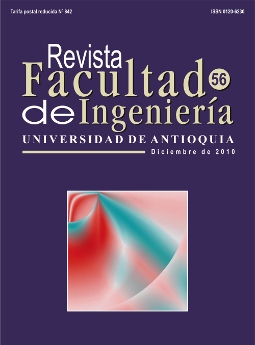From pre-conceptual schemas to OO-Method
DOI:
https://doi.org/10.17533/udea.redin.14668Keywords:
UML, OO-Method, controlled language, conversion rules, pre-conceptual schemasAbstract
OO-Method is an object-oriented method for automated code generation. In order to develop a software application by using OO-Method, the analyst must subjectively create the diagrams included in OO-Method. In this task the analyst must invest too much effort. On the other hand, Pre-conceptual Schemas are controlled-language-based diagrams for knowledge representation. Also, Pre-conceptual Schemas are previous diagrams to conceptual schemas and they are designed for automatically obtaining UML diagrams. In this paper, we take advantage of Pre-conceptual Schemas and we propose a set of rules for obtaining OO-Method diagrams from these Schemas. We also exemplify the proposal with a case study.
Downloads
References
O. Pastor, J Molina. Model-Driven Architecture in Practice. Ed. Springer-Verlag. Berlin. 2007. pp. 49- 146.
OMG. OMG Unified Modeling Language Specification. Object Management Group. Available: http://www.omg.org/UML/. Consultada el 20 de Mayo de 2009.
R. Pressman. Software Engineering: a practitioner’s approach. Ed. McGraw Hill. New York. 2005. pp. 274-281.
C. M. Zapata, A. Gelbukh, F. Arango. “Pre-conceptual Schema: A Conceptual-Graph-Like Knowledge Representation for Requirements Elicitation”. Lecture Notes in Computer Science. Vol. 4293. 2006. pp.17-27. DOI: https://doi.org/10.1007/11925231_3
C. M. Zapata, P. A. Tamayo, F. Arango. “Conversión de Esquemas Preconceptuales a diagrama de casos de uso empleando AToM3”. Revista DYNA. Vol. 74. 2007. pp. 237-251.
C. M. Zapata, L. Lezcano, P. Tamayo. “Validación del Método para la Obtención Automática del Diagrama de Objetivos desde Esquemas Preconceptuales”. Revista EIA. Vol. 8. 2007. pp. 21-35.
O.Pastor, J. Gómez, E. Insfrán, V. Pelechano. “The OOMethod Approach for Information Systems Modeling: From Object-Oriented Conceptual Modeling to Automated Programming”. Information Systems. Vol. 26 .2001. pp. 507-534. DOI: https://doi.org/10.1016/S0306-4379(01)00035-7
V. Pelechano, O. Pastor, E. Insfrán. “Automated code generation of dynamic specializations: an approach based on design patterns and formal techniques”. Data & Knowledge Engineering. Vol. 40. 2002. pp. 315- 353. DOI: https://doi.org/10.1016/S0169-023X(02)00020-4
O. Pastor, E. Insfrán, V. Pelechano, J. Romero, J. Merseguer. “OO-METHOD: An OO Software Production Environment Combining Conventional and Formal Methods”. Lecture Notes in Computer Science. Vol. 1250. 1997. pp. 145-158. DOI: https://doi.org/10.1007/3-540-63107-0_11
P. Molina. “User Interface Generation with OlivaNova Model Execution System”. Proceedings of the 9th International conference on Intelligent user interfaces. Madeira. 2004. pp. 358-359. DOI: https://doi.org/10.1145/964442.964533
O. Pastor, S. Abrahao, J. Fons. “Building e-commerce applications from object-oriented conceptual models”. ACM SIGecom Exchanges. Vol. 2. 2001. pp. 28-36. DOI: https://doi.org/10.1145/844316.844321
G. Giachettii, B. Marim, N. Condori-Fernandezi, J. C. Molina. “Updating OO-Method Function Points”. Proceedings of the 6th International Conference on Quality of Information and Communications Technology. Lisboa. 2007. pp. 55-64. DOI: https://doi.org/10.1109/QUATIC.2007.20
CARE Tecnologies: “OlivaNova: The programming machine”. Available: http://www.care-t.com/index. asp. Consultada el 20 de Mayo de 2009.
P. Haumer, M. Jarke, K. Pohl, K. Weidenhaupt. “Improving reviews of conceptual models by extended traceability to captured system usage”. Interacting with Computers. Vol. 13. 2000. pp. 77-95. DOI: https://doi.org/10.1016/S0953-5438(00)00025-4
Downloads
Published
How to Cite
Issue
Section
License
Copyright (c) 2018 Revista Facultad de Ingeniería

This work is licensed under a Creative Commons Attribution-NonCommercial-ShareAlike 4.0 International License.
Revista Facultad de Ingeniería, Universidad de Antioquia is licensed under the Creative Commons Attribution BY-NC-SA 4.0 license. https://creativecommons.org/licenses/by-nc-sa/4.0/deed.en
You are free to:
Share — copy and redistribute the material in any medium or format
Adapt — remix, transform, and build upon the material
Under the following terms:
Attribution — You must give appropriate credit, provide a link to the license, and indicate if changes were made. You may do so in any reasonable manner, but not in any way that suggests the licensor endorses you or your use.
NonCommercial — You may not use the material for commercial purposes.
ShareAlike — If you remix, transform, or build upon the material, you must distribute your contributions under the same license as the original.
The material published in the journal can be distributed, copied and exhibited by third parties if the respective credits are given to the journal. No commercial benefit can be obtained and derivative works must be under the same license terms as the original work.










 Twitter
Twitter